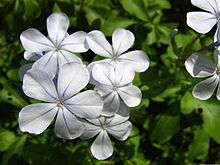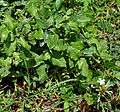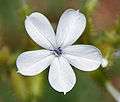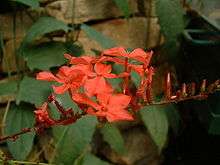Plumbago
| Plumbago | |
|---|---|
 | |
| Plumbago auriculata | |
| Scientific classification | |
| Kingdom: | Plantae |
| (unranked): | Angiosperms |
| (unranked): | Eudicots |
| (unranked): | Core eudicots |
| Order: | Caryophyllales |
| Family: | Plumbaginaceae |
| Subfamily: | Plumbaginoideae |
| Genus: | Plumbago L.[1] |
| Type species | |
| Plumbago europaea L. | |
| Species | |
|
See text | |
Plumbago is a genus of 10-20 species of flowering plants in the family Plumbaginaceae, native to warm temperate to tropical regions of the world. Common names include plumbago and leadwort (names which are also shared by the genus Ceratostigma). The generic name, derived from the Latin words plumbum ("lead") and agere ("to resemble"), was first used by Pliny the Elder (23-79) for a plant known as μολυβδαινα (molybdaina) to Pedanius Dioscorides (ca. 40-90).[2][3] This may have referred to its lead-blue flower colour, the ability of the sap to create lead-colored stains on skin,[4] or Pliny's belief that the plant was a cure for lead poisoning.[5]
The species include herbaceous plants and shrubs growing to 0.5–2 m (1.6–6.6 ft) tall. The leaves are spirally arranged, simple, entire, 0.5–12 cm (0.20–4.72 in) long, with a tapered base and often with a hairy margin. The flowers are white, blue, purple, red, or pink, with a tubular corolla with five petal-like lobes; they are produced in racemes.
The flower calyx has glandular trichomes (hairs), which secrete a sticky mucilage that is capable of trapping and killing insects; it is unclear what the purpose of these trichomes is; protection from pollination by way of "crawlers" (ants and other insects that typically do not transfer pollen between individual plants), or possible protocarnivory.[6]
Mature plumbago leaves often have a whitish residue on their undersides, a feature that can confuse gardeners. While this white material resembles a powdery mildew disease or a chemical spray deposit, it is actually a natural exudate from “chalk” glands that are found on the plumbago species. [7]
Selected species
- Plumbago aphylla Bojer ex Boiss. (Madagascar region)
- Plumbago auriculata Lam. (syn. P. capensis) – Cape Leadwort (South Africa)
- Plumbago caerulea Humboldt, Bonpl. & Kunth (syn. P. coerulea) (Western South America - northern Chile to Colombia)
- Plumbago europaea L. – Common Leadwort (Mediterranean Basin to central Asia)
- Plumbago indica L. (syn. P. rosea) (Southeast Asia)
- Plumbago pulchella Boiss. (Mexico)
- Plumbago scandens L. (sometimes included in P. zeylanica) – Summer Snow Leadwort (Southern United States south to northern South America)
- Plumbago wissii Friedrich (Namibia)
- Plumbago zeylanica L. – Ceylon Leadwort (Africa, the Middle East, South Asia, Southeast Asia, Oceania)[8][9]
Gallery

 Plumbago zeylanica at Ananthagiri Hills
Plumbago zeylanica at Ananthagiri Hills Plumbago zeylanica at Ananthagiri Hills
Plumbago zeylanica at Ananthagiri Hills Plumbago zeylanica at Ananthagiri Hills
Plumbago zeylanica at Ananthagiri Hills Plumbago zeylanica at Ananthagiri Hills
Plumbago zeylanica at Ananthagiri Hills.jpg) Cape Leadwort (Plumbago auriculata)
Cape Leadwort (Plumbago auriculata)
See also
References
| Wikimedia Commons has media related to Plumbago. |
| Wikispecies has information related to: Plumbago |
- ↑ "Plumbago L.". Germplasm Resources Information Network. United States Department of Agriculture. 2002-01-02. Retrieved 2010-01-29.
- ↑ Quattrocchi, Umberto (2000). CRC World Dictionary of Plant Names. 3 M-Q. CRC Press. p. 2117. ISBN 978-0-8493-2677-6.
- ↑ Austin, Daniel F. (2004). Florida Ethnobotany. CRC Press. pp. 527–528. ISBN 978-0-8493-2332-4.
- ↑ Schmelzer, G.H.; A. Gurib-Fakim (2008). Medicinal Plants. Plant Resources of Tropical Africa. p. 427. ISBN 978-90-5782-204-9.
- ↑ Burke, Don (2005). The Complete Burke's Backyard: the Ultimate Book of Fact Sheets. Murdoch Books. p. 268. ISBN 978-1-74045-739-2.
- ↑ Schlauer, Jan (1997). ""New" data relating to the evolution and phylogeny of some carnivorous plant families". Carnivorous Plant Newsletter. International Carnivorous Plant Society. 26 (2): 34–38.
- ↑ “New Thrips Found on Plumbago” by Doug Caldwell (PDF).
- ↑ "Plumbago zeylanica L.". Germplasm Resources Information Network. United States Department of Agriculture. 1996-03-19. Retrieved 2010-01-29.
- ↑ "Species Records of Plumbago". Germplasm Resources Information Network. United States Department of Agriculture. Retrieved 2010-01-29.
- Flora of Chile: Plumbago (pdf file)
- Flora of China: Plumbago
- Flora of Ecuador: Plumbago
- Flora Europaea: Plumbago
- Flora of North America: Plumbago
- Flora of Pakistan: Plumbago
External links
- Caldecott, Todd (2006). Ayurveda: The Divine Science of Life. Elsevier/Mosby. ISBN 0-7234-3410-7. Contains a detailed monograph on Plumbago zeylanica (Chitraka) as well as a discussion of health benefits and usage in clinical practice. Available online at http://www.toddcaldecott.com/index.php/herbs/learning-herbs/378-chitraka

